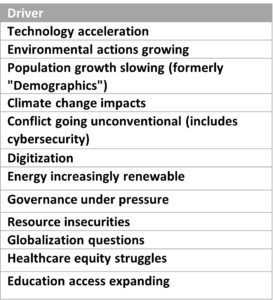One of the annoying aspects of dealing with large volumes of information that we futurists encounter is how to categorize and characterize that information. A few weeks ago I shared a list of my Top 10 drivers for 2023, but I didn’t tell you about some work we at Houston Foresight have done on naming drivers.

We did a project that perused hundreds of reports looking for drivers. We ended up finding hundreds of drivers … well, sorta. A lot of items called drivers really weren’t, according to our definition and some things not called drivers really were. Here’s the definition we use:
A driver is a thematic cluster of related inputs from scanning and research i.e., scan hits, trends, issues, that is driving or shaping change in a domain.
We see drivers as key outputs of scanning and research and we use them as building blocks for scenarios.
Now for this project, with hundreds of candidates, we needed to sort the number down to a more manageable number (we got it to 27).
In the process we found what we think is a useful naming convention (see image above for examples). The name starts with the topic that is the change and then characterizes that change. So instead of increasing climate change, the order is climate change increasing. This was done with all the driver names. The team also avoided “the” or putting the topic in the middle. This makes it immediately clear what the change is. An added benefit is that this consistent format makes it easier to sort and analyze them. With this approach a list of 600+ can be sorted alphabetically and get you very close to initial clusters. The other benefit is the consistency in naming is helpful to the reader. They know what to expect and don’t have to decipher multiple conventions.
We share this hoping that you might find it useful. In my view, the more consistent we are, the easier it is for clients or potential clients to grasp what we are doing. – Andy Hines

Leave a Reply